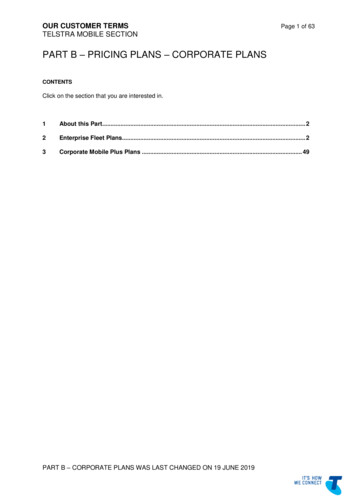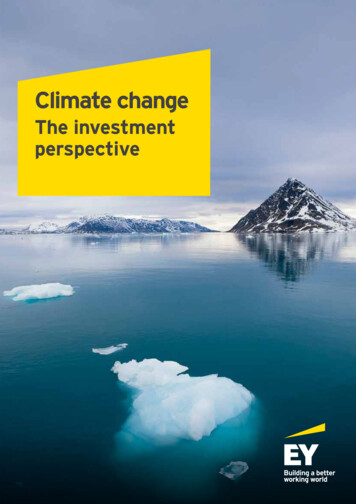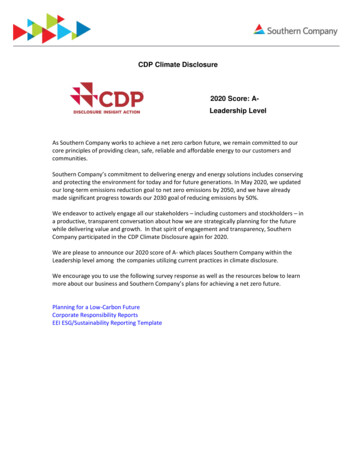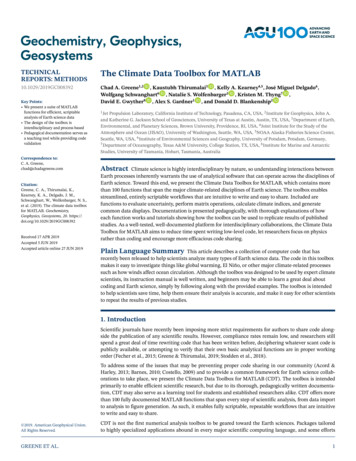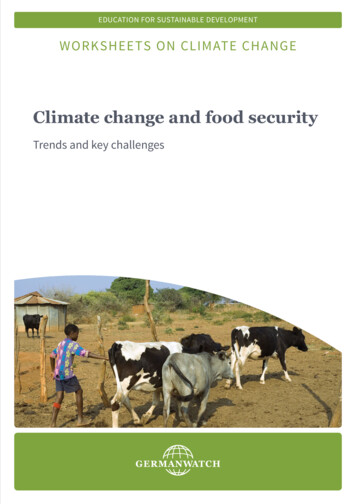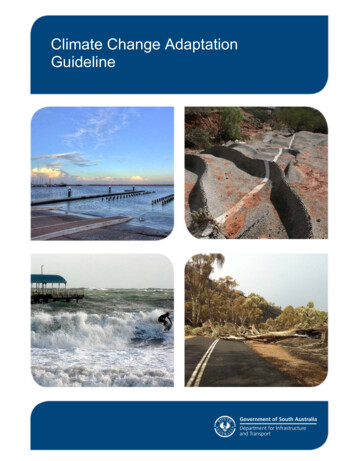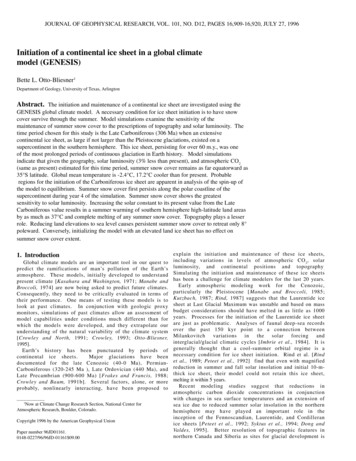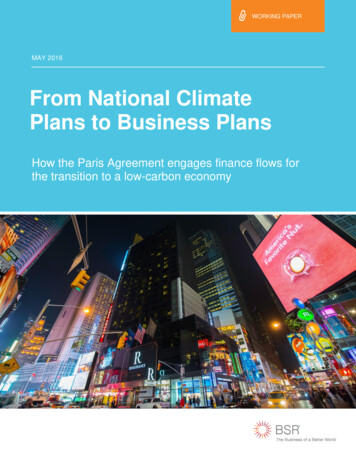
Transcription
WORKING PAPERMAY 2016From National ClimatePlans to Business PlansHow the Paris Agreement engages finance flows forthe transition to a low-carbon economy
BSR From National Climate Plans to Business Plans1About This ReportThis working paper was written by Smruti Govan, Remi Moncel, and David Wei, with the assistance of ourcolleagues at BSR. It is based on independent research and data analysis conducted by BSR with thesupport of the ClimateWorks Foundation. For additional information, please contact David Wei(dwei@bsr.org).Last December the 197 parties to the United Nations Framework Convention on Climate Changeconcluded the Paris Agreement. Pursuant to the agreement, 189 countries have brought forward nationalclimate plans to reduce greenhouse gas emissions and build resilience. One of the stated purposes of theagreement is to shift finance flows toward low-emission and climate-resilient development. This workingpaper measures how strongly national governments’ climate plans signal to the private sector this shift toa new mode of global economic development. By articulating practical insights on how governments canamplify these signals, this paper also aims to strengthen such finance flows over time.We interpret finance flows broadly to include both investment and procurement, and we look to threegroups of private sector actors who are essential to mobilizing these flows: the investment community,energy and extractives companies, and companies with large supply chains. This broad interpretation iscommensurate with both the breadth of the finance flows national climate plans seek to influence and thescale of the climate challenge, which will require the mobilization of trillions of dollars.The research for this working paper was conducted over four months and included a comprehensivereview of the national climate plans and related literature, as well as semi-structured, anonymousinterviews to harvest candid insights from corporate executives and sustainability practitioners,institutional investors, and leading private-sector consultants. Through these interviews we have gatheredinsights from 33 experts across a range of sectors.This working paper is organized into three sections. The first introduces the Paris Agreement, itspurposes, and the national climate plans that governments have developed under it. The second sectionprovides an overview of findings that cuts across insights from our three groups of private-sector actors.The third section then canvasses findings that are specific to a single group. We conclude with somerecommendations on how to strengthen the signals sent by the national climate plans to the privatesector.ACKNOWLEDGMENTSThe authors wish to thank all of the interviewees and peer reviewers—all of whom were promisedanonymity—for their insights, feedback, and recommendations. The authors also wish to thank theClimateWorks Foundation for their generous support and contribution to this report.DISCLAIMERBSR publishes occasional papers as a contribution to the understanding of the role of business in societyand the trends related to corporate social responsibility and responsible business practices. BSRmaintains a policy of not acting as a representative of its membership, nor does it endorse specificpolicies or standards. The views expressed in this publication are those of its authors and do not reflectthose of BSR members.
BSR From National Climate Plans to Business Plans2Working papers contain preliminary research, analysis, findings, and recommendations. They arecirculated to stimulate timely discussion and critical feedback and to influence ongoing debate onemerging issues. Most working papers are eventually published in another form, and their content may berevised.SUGGESTED CITATIONGovan, S.; Moncel, R.; Wei, D. 2016. “From National Climate Plans to Business Plans.” BSR WorkingPaper, BSR.
BSR From National Climate Plans to Business Plans3ContentsExecutive Summary4Introduction6Crosscutting Findings10Group-Specific Findings16Conclusion: Toward Transformative National Climate Plans23Appendix24References27
BSR From National Climate Plans to Business Plans4Executive SummaryThe Paris Agreement on climate change marks a true turning point in thepolicy environment for businesses and investors. One of its statedpurposes is to shift finance flows toward a low-carbon, climate-resilientglobal economy. The national climate plans brought forward by 189countries under the agreement accelerate this shift.Shifting Finance FlowsThe Paris Agreement explicitly recognizes that shifting finance flows is essential to building the thrivingclean economy it envisions. Without new modes of investment and operations from the investmentcommunity, energy and extractives companies, and companies with large supply chains, these flowscannot be mobilized.Corporate practitioners and private-sector consultants across these three groups assessed the signalssent by the major economies’ national climate plans. In particular, they agree that:1. The national climate plans collectively signal a shift toward a low-carbon economy.2. Businesses recognize the need to respond to the national climate plans, but the degree to whichthey currently integrate climate and energy policy into decision-making varies widely.3. The national climate plans are an important guidepost for business decision-making, but are oftensecondary to other factors.4. The more predictable and transparent a country’s implementation, the more credible andpersuasive its national climate plan.5. Sector-specific policies tend to be the most persuasive. Milestones, timelines, and carbon pricingalso strengthen the credibility of national climate plans.6. Governments are least persuasive when sending mixed policy signals and most persuasive whenbuilding national carbon prices and sectoral policies that strengthen the enabling environment fora low-carbon economy.Toward Transformative National Climate PlansIn the post-Paris period, many businesses and investors are willing to transition to a new low-carbon andclimate-resilient global economy, but they are looking for the stable and certain implementation of thenational climate plans as well as other signals to the private sector that national governments arecommitted to this global transition. Based on our research, we make the following recommendations togovernments as they clarify and strengthen their national climate plans under the Paris Agreement:
BSR From National Climate Plans to Business Plans5» Implement the national climate plans with stability and certainty, and articulate in detailimplementation and review mechanisms for these plans at the international, national, and subnational levels.» Provide additional specificity to make the national climate plans more directly actionable bycompanies, including interim targets, sectoral specificity, and policies that establish explicit andimplicit carbon pricing.» Improve policies that currently impede the sustainable finance flows envisioned by the nationalclimate plans, such as governance shortcomings and fossil fuel subsidies that slow the transition toa low-carbon economy and weaken national governments’ credibility.» Build sectoral policies into the national climate plans that support low-emission and climate-resilientfinance flows—for example, on land-use and agriculture, transport, or research and development.Businesses and investors are ready to act upon the national climate plans. By implementing andimproving them, governments will make these plans more directly actionable and stimulate the financeflows essential to implementing the Paris Agreement in the real economy.
BSR From National Climate Plans to Business Plans6IntroductionIn December 2015, the Paris Climate Conference (COP21) successfullyconcluded four years of negotiations toward a new global climate agreement.The Paris Agreement, adopted by consensus by the 197 Parties to theUnited Nations Framework Convention on Climate Change (UNFCCC), isthe first agreement to require that developed and developing countries alikeundertake national climate plans to reduce greenhouse gas emissions andbuild climate resilience. Engagement by the private sector will be critical tomeeting the Paris Agreement’s objectives.The Paris outcome shifts the policy environment for companies and the investment community toward alow-carbon, climate-resilient economy in the long term, the medium term, and the short term.In the long term, the Paris Agreement steers the world toward a low-carbon, climate-resilient globaleconomy through three global goals: to hold global warming well below 2 C, with a stretch target of1.5 C;1 to reach net zero global greenhouse gas emissions in the second half of this century;2 and to builda climate-resilient world.3 The Agreement also mandates that countries prepare new national climateplans every five years, following an assessment of national governments’ collective progress towardthese global goals.4 Each new national climate plan must be more aggressive than the previous one andreflect the country’s highest possible ambition.5 National climate plans will therefore become moreambitious as low-emission technologies mature, pushing the global emissions trajectory downward.In the medium term, 189 countries accounting for 98.8 percent of global emissions have now submittednational climate plans to reduce emissions and build resilience under the Paris Agreement, setting targetsfor 2025 or 2030.6 Collectively, these plans reduce projected warming by 2100 to around 2.7 C,compared with previous projected warming of up to 4.8 C.7 The International Energy Agency estimatesthat implementation of the plans brought forward for Paris will require US 13.5 trillion of investment inUN Framework on the Convention on Climate Change Secretariat (UNFCCC), “Adoption of the Paris Agreement: Article 4.2 of theParis Agreement.” Accessed, May 2, 2016. 9.pdf. (hereinafter “Paris AgreementArticle 4.2”).12Paris Agreement Article 4.1.3Paris Agreement Article 7.1.4Paris Agreement Articles 4.9, 14.5Paris Agreement Article 4.3.6World Resources Institute, “Climate Data Explorer.” Accessed May 2, 2016. http://cait.wri.org/indc/.International Energy Agency, “Energy and Climate Change: World Energy Outlook, COP 21 Briefing.” Accessed May 2, WEO2015 COP21Briefing.pdf.7
BSR From National Climate Plans to Business Plans7energy efficiency and low-carbon technologies by 2030.8 Carbon pricing by governments, and shadowcarbon pricing by companies in anticipation of regulation, will be crucial to mobilizing this investment.In the short term, the “Action Agenda” in Paris showcased current climate action—sector by sector—bybusinesses, investors, and sub-national governments.9 This made clear both the scale of private-sectoraction and the specific best-in-class commitments and collaborations being undertaken in each sector. Asimilar showcase will now occur annually at each UN climate conference through 2020, providing anatural forum for business leadership to share best practices.10 Technical work on scaling up practicalinitiatives to reduce emissions and build resilience will also continue under UN auspices through 2020.Recognizing that the national climate plans under the Paris Agreement must catalyze private-sectoraction and investment in order to achieve the Agreement’s short-, medium-, and long-term goals, thisworking paper asks whether these national plans, with their climate policies and targets to 2025 and/or2030, send the requisite signal to companies and the investment community to facilitate the globaltransition to a low-carbon, climate-resilient economy.Shifting Finance FlowsArticle 2.1 sets out the purposes of the Paris Agreement, which include holding global warming “to wellbelow 2 C above preindustrial levels and pursuing efforts to limit [warming] to 1.5 C above preindustriallevels” and “increasing the ability to adapt to the adverse impacts of climate change and foster climateresilience and low greenhouse gas emissions development.” These two purposes—to mitigate climatechange and to adapt to it—are buttressed by a third purpose, “making finance flows consistent with apathway toward low greenhouse gas emissions and climate-resilient development.”11By including this third purpose in the Paris Agreement, governments recognized that tackling climatechange will require more than public finance. They recognized that only by shifting broader private- sectorfinance flows can we successfully construct the low-carbon, climate-resilient economy envisioned by theagreement. With respect to the national climate plans now brought forward, this clearly directs us to twoquestions:1. How strong are the signals sent by the national climate plans to actors in the private sector, andin particular to companies and investors whose engagement is essential to shifting finance flowstoward low-carbon, climate-resilient development?2. How can governments improve their national climate plans to send stronger signals to the privatesector?In this working paper we consider three groups of private sector actors without whom the finance flowsenvisioned by the Paris Agreement cannot be mobilized.8International Energy Agency (IEA), 2015.UN Framework Convention on Climate Change, “Lima-Paris Action Agenda.” Accessed April 29, 2016.http://newsroom.unfccc.int/lpaa/.910Paris Agreement, Decision 1/CP21, paras. 121.11Paris Agreement, Article 2.1.
BSR From National Climate Plans to Business Plans8It is significant that although Paris is non-binding onmeeting the [targets in national climate plans] it doesbind countries to keep contributing to them andincreasing stringency. It is certain that what is on thetable now will get more stringent relatively quickly,especially every five years.—Large multinational energy companyFirst, we consider the
BSR From National Climate Plans to Business Plans 7 energy efficiency and low-carbon technologies by 2030.8 Carbon pricing by governments, and shadow carbon pricing by companies in anticipation of regulation, will be crucial to mobilizing this investment. In the short term, the Action Agenda in Paris showcased current climate action—sector by sector—by businesses, investors, and
